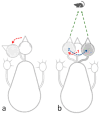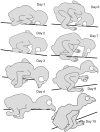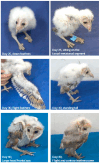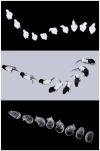Post-Hatching Development of Posture and Behavior in the Barn Owl (Tyto alba): From a General Behavioral Pattern of Vertebrates to the Typical Owl Behavior
- PMID: 39452142
- PMCID: PMC11504010
- DOI: 10.3390/biology13100834
Post-Hatching Development of Posture and Behavior in the Barn Owl (Tyto alba): From a General Behavioral Pattern of Vertebrates to the Typical Owl Behavior
Abstract
Hatching captive barn owl chicks underwent four developmental phases. In the first 10 days (phase 1), behavior consisted of lateral movements that gradually changed to forward progression and peaked a few days before and after eye-opening. This behavior resembled a general developmental pattern that characterizes other vertebrates. Chicks also underwent a postural change, from head bent underneath the ventrum to resting on the rear end of the trunk with the head lifted in the air. Then, once their eyes were opened, chicks became more stationary and preoccupied with visual exploration, manifested in lateral head movements and peering episodes (phase 2, until day 20). The latter behavior, which is also typical of mature owls when not on the wing, characterized the chicks' behavior after post-hatching day 20 (phase 3), when their flight and contour feathers grew, along with shedding the down plumage and standing tall. Development culminated in active flight, first observed by days 50-60 (phase 4). Altogether, during post-hatching development, barn owl chicks gradually shifted from egg posture to the adult upright body posture. At the same time, their behavior consisted of speciation from the general developmental pattern to the typical stationary barn owl behavior, and, finally, flight was incorporated.
Keywords: fledglings; hatchlings; mobility gradient; motion parallax; peering; pivoting; warm up.
Conflict of interest statement
Both authors declare no conflicts of interest.
Figures














Similar articles
-
Morphometric characterisation of wing feathers of the barn owl Tyto alba pratincola and the pigeon Columba livia.Front Zool. 2007 Nov 21;4:23. doi: 10.1186/1742-9994-4-23. Front Zool. 2007. PMID: 18031576 Free PMC article.
-
How barn owls (Tyto alba) visually follow moving voles (Microtus socialis) before attacking them.Physiol Behav. 2009 Sep 7;98(3):359-66. doi: 10.1016/j.physbeh.2009.06.016. Epub 2009 Jul 3. Physiol Behav. 2009. PMID: 19577583
-
Avian Binocularity and Adaptation to Nocturnal Environments: Genomic Insights from a Highly Derived Visual Phenotype.Genome Biol Evol. 2019 Aug 1;11(8):2244-2255. doi: 10.1093/gbe/evz111. Genome Biol Evol. 2019. PMID: 31386143 Free PMC article.
-
Neuroethology of prey capture in the barn owl (Tyto alba L.).J Physiol Paris. 2013 Jan-Apr;107(1-2):51-61. doi: 10.1016/j.jphysparis.2012.03.004. Epub 2012 Apr 7. J Physiol Paris. 2013. PMID: 22510644 Review.
-
Barn owls specialized sound-driven behavior: Lessons in optimal processing and coding by the auditory system.Hear Res. 2024 Mar 1;443:108952. doi: 10.1016/j.heares.2024.108952. Epub 2024 Jan 15. Hear Res. 2024. PMID: 38242019 Review.
References
-
- Knudsen E.I. The hearing of the barn owl. Sci. Am. 1981;245:113–125. doi: 10.1038/scientificamerican1281-112. - DOI
-
- Collett T.S. Peering—A locust behavior pattern for obtaining motion parallax information. J. Exp. Biol. 1978;76:237–241. doi: 10.1242/jeb.76.1.237. - DOI
-
- Wallace G.K. Visual scanning in the desert locust Schistocerca gregaria, Forskal. J. Exp. Biol. 1959;36:512–525. doi: 10.1242/jeb.36.3.512. - DOI
LinkOut - more resources
Full Text Sources
Miscellaneous

